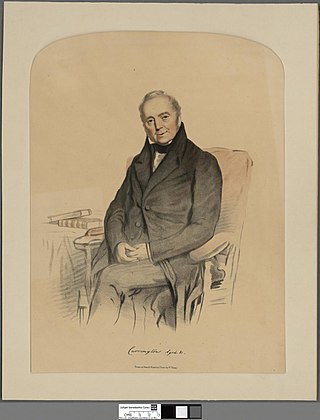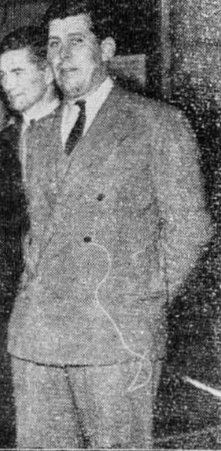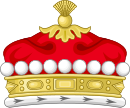
Field Marshal John Standish Surtees Prendergast Vereker, 6th Viscount Gort, was a senior British Army officer. As a young officer during the First World War, he was decorated with the Victoria Cross for his actions during the Battle of the Canal du Nord. During the 1930s he served as Chief of the Imperial General Staff. He is best known for commanding the British Expeditionary Force that was sent to France in the first year of the Second World War, only to be evacuated from Dunkirk the following year. Gort later served as Governor of Gibraltar and Malta, and High Commissioner for Palestine and Transjordan.

Earl of Donoughmore is a title in the Peerage of Ireland. It is associated with the Hely-Hutchinson family. Paternally of Gaelic Irish descent with the original name of Ó hÉalaighthe, their ancestors had long lived in the County Cork area as allies of the Mac Cárthaigh clan; they lost out during the times of Oliver Cromwell. One branch of the family converted to the Anglican Church and after inheriting territories through his mother and adding "Hutchinson" to Hely, became the Earl of Donoughmore.

Viscount Massereene is a title in the Peerage of Ireland. It was created in 1660, along with the subsidiary title of Baron Loughneagh. From 1665 to 1816 the Skeffington Baronetcy of Fisherwick was attached to the viscountcy and from 1756 to 1816 the Viscounts also held the title of Earl of Massereene. Since 1843 the peerages are united with titles of Viscount Ferrard, of Oriel and Baron Oriel, both in the Peerage of Ireland, and Baron Oriel, in the Peerage of the United Kingdom. The Viscount also holds the subsidiary titles of Baron Loughneagh (1660) and Baron Oriel (1790) in the Peerage of Ireland and Baron Oriel (1821) in the Peerage of the United Kingdom. As Baron Oriel, he sat in the House of Lords until 1999.

Viscount Hill, of Hawkstone and of Hardwicke in the County of Salop, is a title in the Peerage of the United Kingdom. It was created in 1842 for General Rowland Hill. He had already been created Baron Hill, of Almaraz and of Hawkstone in the County of Salop, in 1814, with remainder to the heirs male of his body, and Baron Hill, of Almarez and of Hawkestone and Hardwicke in the County of Salop, in 1816, with remainder to the heirs male of his elder brother John Hill. The viscountcy was created with the same special remainder. On the first Viscount's death in 1842, the barony of 1814 became extinct as he had no male issue, while he was succeeded in the barony of 1816 and the viscountcy according to the special remainders by his nephew Sir Rowland Hill, 4th Baronet. His son, the 3rd Viscount, sat as a Conservative Member of Parliament for Shropshire North. In 1875, he assumed by royal licence the additional surname of Clegg, which was that of his maternal grandfather. He inherited financial problems from his father which led to the breakup and sale of the family estates.

Viscount St Vincent, of Meaford in the County of Stafford, is a title in the Peerage of the United Kingdom. It was created on 27 April 1801 for the noted naval commander John Jervis, Earl of St Vincent, with remainder to his nephews William Henry Ricketts and Edward Jervis Ricketts successively, and after them to his niece Mary, wife of William Carnegie, 7th Earl of Northesk. He had already been created Baron Jervis, of Meaford in the County of Stafford, and Earl of St Vincent, in the Peerage of Great Britain, on 23 August 1797, with normal remainder to his heirs male. On Lord St Vincent's death in 1823 the barony and earldom became extinct while he was succeeded in the viscountcy according to the special remainder by his nephew, the second viscount. In 1823 he assumed by royal licence the surname of Jervis in lieu of Ricketts. His great-grandson, the fourth viscount, was part of the force that was sent in 1884 to rescue General Gordon at Khartoum, and died from wounds received at the Battle of Abu Klea in January 1885. He was succeeded by his younger brother, the fifth viscount. As of 2013 the title is held by the eighth viscount, who succeeded his father in September 2006.

Baron Carrington is a title that has been created three times, once in the Peerage of England, once in the Peerage of Ireland and once in the Peerage of Great Britain.

Viscount Grandison, of Limerick, is a title in the Peerage of Ireland. It was created in 1620 for Sir Oliver St John, the Lord Deputy of Ireland. He was the descendant and namesake of Oliver St John, whose elder brother Sir John St John was the ancestor of the Barons St John of Bletso and the Earls of Bolingbroke. Moreover, St John's nephew Sir John St John, 1st Baronet, of Lydiard Tregoze, was the ancestor of the Viscounts Bolingbroke and the Viscounts St John.

Viscount Clifden, of Gowran in the County of Kilkenny, Ireland, was a title in the Peerage of Ireland. It was created on 12 January 1781 for James Agar, 1st Baron Clifden. He had already been created Baron Clifden, of Gowran in the County of Kilkenny, in 1776, also in the Peerage of Ireland. The Viscounts also held the titles of Baron Mendip in the Peerage of Great Britain from 1802 to 1974 and Baron Dover from 1836 to 1899, when this title became extinct, and Baron Robartes from 1899 to 1974, when this title became extinct, the two latter titles which were in the Peerage of the United Kingdom. The interrelated histories of the peerages follow below.

The Rt. Hon. Standish O'Grady, 1st Viscount Guillamore, PC, from Cahir Guillamore, County Limerick, served as Lord Chief Baron of the Exchequer for Ireland for a number of years. He was created Viscount Guillamore by a patent of 28 January 1831.
John Prendergast-Smyth, 1st Viscount Gort was an Irish politician.
This is a list of people who have held the post of Lord Lieutenant of County Galway.
Gort is a town in Galway, Ireland.
Standish Robert Gage Prendergast Vereker, 7th Viscount Gort, was an Anglo-Irish peer, connoisseur and collector of fine art, antiques, and objets d'art, whose seat was at Hamsterley Hall, County Durham. He was appointed High Sheriff of Durham in 1934. He was the brother of John Vereker, 6th Viscount Gort, and inherited that title on the death of Lord Gort without male issue in 1946. He was succeeded in turn by his cousin, Colin Vereker.

Colin Leopold Prendergast "Kim" Vereker, 8th Viscount Gort, JP was an Irish peer and member of the House of Keys.

Charles Vereker, 2nd Viscount Gort PC (Ire), known as Charles Vereker until 1817, was an Irish soldier and politician.
John Prendergast Vereker, 3rd Viscount Gort, was an Anglo-Irish peer and politician.
Vereker is a surname. Notable people with the surname include:
John Gage Prendergast Vereker, 5th Viscount Gort was an Anglo-Irish peer, landowner and Army officer.
Charles Smyth (1693–1784) was an Irish politician who served as Member of Parliament for Limerick City for 45 years.
John Prendergast Vereker was an Anglo-Irish lawyer and politician. He was the Lord Mayor of Dublin from 1863 to 1864.












